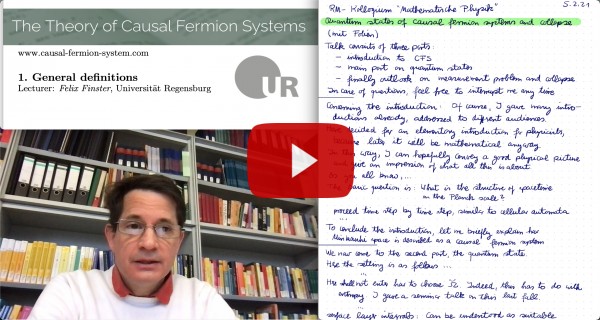The Theory of Causal Fermion Systems
The Linearized Field Equations
Prerequisites
Continue Reading
Related Topics
The Linearized Field Equations

The Linearized Field Equations
Mimicking the usual procedure for linearizing physical equations, we consider a family $(\tilde{\rho})_\tau$ of measures parametrized by $\tau \in (-\delta, \delta)$ which all satisfy the Euler-Lagrange equations and linearize in the parameter $\tau$. Assuming that the measures are obtained by a push-forward and a change of weight, i.e.
\[ \tilde{\rho}_\tau = (F_\tau)_* \big( f_\tau \,\rho \big) \]
with $F_\tau \in C^\infty(M, \F)$ and $f_\tau \in C^\infty(M, \R^+)$, these variations can be described linearly in $\tau$ by the jet
\[ \mathfrak{v} := \frac{d}{d\tau} \big( f_\tau, F_\tau \big) \big|_{\tau=0} \]
(for details see [jet16]; more general variations allowing for a so-called fragmentation of the measure are considered in [perturb17, Section 5]). The fact that the variation described infinitesimally by the jet preserves the Euler-Lagrange equations gives rise to the linearized field equations
\[ \la \mathfrak{u}, \Delta \mathfrak{v} \ra|_M = 0 \:, \]
to be satisfied for all test jets $\mathfrak{u}$, where the Laplacian $\Delta$ is defined by
\[ \la \mathfrak{u}, \Delta \mathfrak{v} \ra(x) := \nabla_{\mathfrak{u}} \bigg( \int_M \big( \nabla_{1, \mathfrak{v}} + \nabla_{2, \mathfrak{v}} \big) \L(x,y)\: d\rho(y) – \nabla_\mathfrak{v} \mathfrak{s} \bigg) \:.\]
(for details see [jet16] or the summary in [perturb17, Section 3.3]).
The Surface-Layer One-Form
The linearized field equations gives rise to conservation laws expressed in terms of surface layer integrals, as we now outline. In [osi18] the so-called surface layer one-form is introduced by
\[ \gamma^\Omega_\rho(\mathfrak{v}) = \int_\Omega d\rho(x) \int_{M \setminus \Omega} \big( \nabla_{1,\mathfrak{v}} – \nabla_{2,\mathfrak{v}} \big) \L(x,y) \Big) \: d\rho(y) \:. \]
This surface layer integral is conserved if the jet $\mathfrak{v}=(0,v)$ has a vanishing scalar component. If $v$ generates a symmetry, this conservation law gives back the Noether-like theorems. It generalizes the Noether-like theorems because all we need is that $v$ is a solution of the linearized field equations, but no symmetry assumptions are needed.
The Symplectic Form
In [jet16] it is shown that the linearized field equations also give rise to a another conservation law. Indeed, for two solutions $\mathfrak{u}$ and $\mathfrak{v}$, the symplectic form $\sigma_\Omega$ defined by
\[ \sigma^\Omega_\rho(\mathfrak{u}, \mathfrak{v}) = \int_\Omega d\rho(x) \int_{M \setminus \Omega} \Big( \nabla_{1,\mathfrak{u}} \nabla_{2,\mathfrak{v}} \L(x,y) – \nabla_{1,\mathfrak{v}} \nabla_{2,\mathfrak{u}} \L(x,y) \Big) \: d\rho(y) \]
is conserved (again in the sense that its value is preserved if $\Omega$ is changed by a compact set).
In [action17] it is shown that in the example of causal fermion systems in Minkowsi space and the Maxwell field, the above surface layer integral reduces to the symplectic form of classical field theory.
The Surface Layer Inner Product
In [osi18] a general class of conserved surface layer integrals is derived. Most interesting for the applications is the surface layer inner product defined by
\[ (\mathfrak{u}, \mathfrak{v})^\Omega_\rho = \int_\Omega d\rho(x) \int_{M \setminus \Omega} \Big( \nabla_{1,\mathfrak{u}} \nabla_{1,\mathfrak{v}} \L(x,y) – \nabla_{2,\mathfrak{v}} \nabla_{2,\mathfrak{u}} \L(x,y) \Big) \: d\rho(y) \]
As a consequence of the second derivatives acting on the same variable, this surface layer integral depends on the choice of coordinates on $\F$. A related issue is that it is conserved only approximately. In [action17] it is shown that in the example of causal fermion systems in Minkowsi space and the Maxwell field, it reduces to the scalar product used in quantum field theory obtained by inserting a frequency splitting into the symplectic form. The freedom in choosing the frequency splitting corresponds to the freedom in choosing the coordinates of $\F$.
The surface layer inner product is used in the existence theory for the linearized field equations for getting energy estimates (see [linhyp18]). Moreover, it is used in [FK18] for giving the linearized solutions an almost complex structure.
→ the dynamical wave equation
→ construction of linear fields and waves

Felix Finster
Author